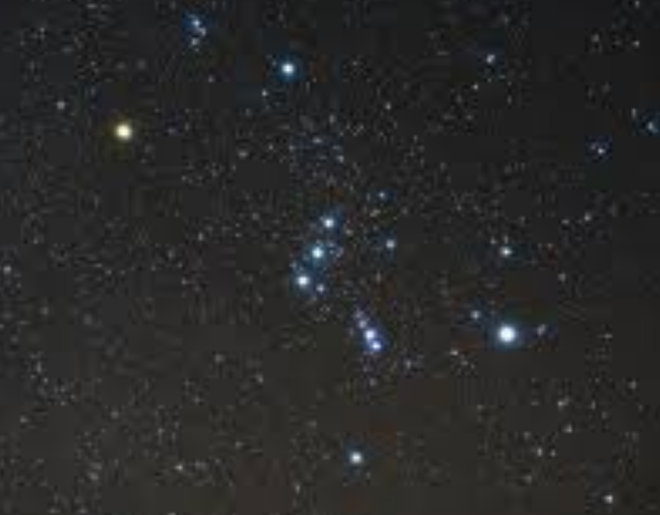Updated Tuesday afternoon.... December 18.....Comet 46P/Wirtanen, otherwise known as the Christmas Comet will be visible tonight.The comet reached it's closest to the earth, 7.4 million miles, on Sunday night. It will be visible for the next week or so, however lots of clouds will be moving back in after tonight and tomorrow.This is one of the 10 closest comets to earth. The distance is about 30 times the distance of the earth to the moon. The closest comet ever came within about 6 times the distance to the moon or about 1.5 million miles.The comet is about 1/13th the distance from the earth to the sun.How do you see it......This is not visible to the naked eye. You will need binoculars. There may be some high clouds this evening, but they should clear out as the evening goes on.You need a DARK location.In the eastern sky this evening you will see the constellation Orion..Orion is easy to find with the 3 stars in a row. That is the belt of Orion.OK...from Orion, go up and to the right and you will see a bright star. That is Aldebaran. This is the brightest star in the constellation, Taurus.Now go up some more and you will see a hazy patch in the sky. That is not the comet. It is the Pleiades, also known as the "Seven Sisters." This is a star cluster and if you can see at least 7 stars in the cluster, then you have good viewing conditions.OK...we are almost to the comet. A little up and a little to the left of the Pleiades is the comet. It will only be in this position for tonight.With binoculars you may see a little smudge of light. That is the comet. Good luck!Below are some scenes of the comet. Many of these photos were with time exposures so that would be brighter than the naked eye.Photographic advice from photographer Juan Carlos Casado courtesy of spaceweather.com“Use Raw file format, a fast lens (at least f/2.8) and ISO settings between 1600 and 3200. The exposure will depend on the focal length. I normally use the 500 rule–that is, exposure = 500 / focal (mm) with a tripod. It also helps in areas with light pollution to use an antipollution filter. I am now using Optolong L-Pro clip filter which gives excellent color balance.”
Updated Tuesday afternoon.... December 18.....
Comet 46P/Wirtanen, otherwise known as the Christmas Comet will be visible tonight.
The comet reached it's closest to the earth, 7.4 million miles, on Sunday night. It will be visible for the next week or so, however lots of clouds will be moving back in after tonight and tomorrow.
This is one of the 10 closest comets to earth. The distance is about 30 times the distance of the earth to the moon. The closest comet ever came within about 6 times the distance to the moon or about 1.5 million miles.
The comet is about 1/13th the distance from the earth to the sun.
How do you see it......
This is not visible to the naked eye. You will need binoculars. There may be some high clouds this evening, but they should clear out as the evening goes on.
You need a DARK location.
In the eastern sky this evening you will see the constellation Orion.
.
Orion is easy to find with the 3 stars in a row. That is the belt of Orion.
OK...from Orion, go up and to the right and you will see a bright star. That is Aldebaran. This is the brightest star in the constellation, Taurus.
Now go up some more and you will see a hazy patch in the sky.
That is not the comet. It is the Pleiades, also known as the "Seven Sisters." This is a star cluster and if you can see at least 7 stars in the cluster, then you have good viewing conditions.
OK...we are almost to the comet. A little up and a little to the left of the Pleiades is the comet. It will only be in this position for tonight.
With binoculars you may see a little smudge of light. That is the comet. Good luck!
Below are some scenes of the comet. Many of these photos were with time exposures so that would be brighter than the naked eye.
Photographic advice from photographer Juan Carlos Casado courtesy of spaceweather.com
“Use Raw file format, a fast lens (at least f/2.8) and ISO settings
between 1600 and 3200. The exposure will depend on the focal length. I
normally use the 500 rule–that is, exposure = 500 / focal (mm) with a
tripod. It also helps in areas with light pollution to use an
antipollution filter. I am now using Optolong L-Pro clip filter which
gives excellent color balance.”
This content is imported from Twitter.
You may be able to find the same content in another format, or you may be able to find more information, at their web site.
This content is imported from Twitter.
You may be able to find the same content in another format, or you may be able to find more information, at their web site.
This content is imported from Twitter.
You may be able to find the same content in another format, or you may be able to find more information, at their web site.




